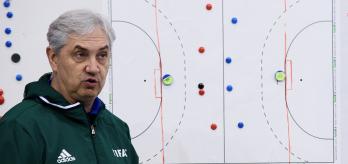Organisation
-
Use a full-size court.
-
Divide the court into three zones.
-
The middle zone is marked out either side of the halfway line and is 10m in length.
-
The overall game is a 5v5, including goalkeepers.
-
Create a 2v1 scenario in the first zone.
-
Set up a 1v1 scenario in the middle zone.
-
Organise a 1v2 scenario in the third zone.
Explanation
-
The goalkeeper starts the play by passing the ball to a team-mate in the first zone.
-
The player must try to dribble the ball into the middle zone.
-
This creates an overload or a numerical disadvantage (2v1).
-
The 2 players then try to progress the ball into the final third (third zone).
-
The aim is to score in the opposition goal.
-
When progressing play, the ball cannot be played back to a previous zone.
Variations
-
Variation 1: once the ball reaches the final third, an extra player from each team can enter this zone to create a 3v2 or 3v3 situation.
-
Variation 2: all attackers can enter the final third.
-
Variation 3: all players can enter the final third
Coaching points
-
Emphasis should be placed on ball retention to ensure that a team do not lose their numerical advantage.
-
Players should dribble at pace, with purpose and towards the opposition goal at all times to help progress the ball through the thirds effectively.
-
Intelligent off-the-ball movement can create and open up space for key passes to be played in attack.
-
Player should create passing lines in the final third to help work angles for attempts on goal.
-
Ball carriers must follow their pass through and offer a passing option once they progress into the next zone.
-
Ball carriers can make a range of forward movements, such as running straight through the middle, running down the wings, making diagonal runs and performing directional changes.

























